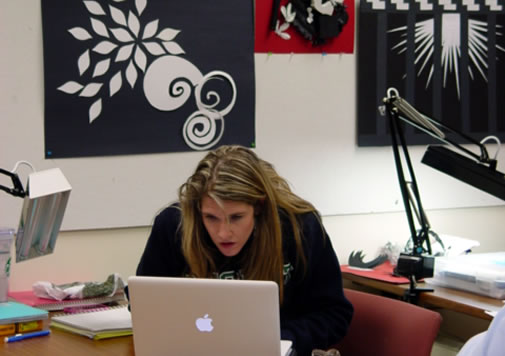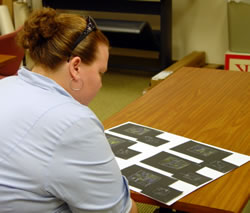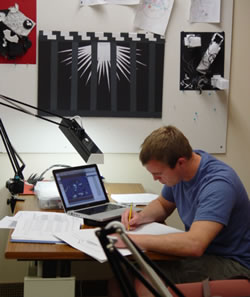Commissions
How to make it all Fit?

Carissa Hawksworth analyzes the use of lighting in a still photo for her lighting design project. In the background are projects on line, shape and texture.
Images/Courtesy Regent University's Design Process I course for the MA in Theatre.
I imagine I’m not alone writing the syllabus for a design class and wondering how to fit everything in. The problem seems always to be the same: too much material and not enough time. The fundamental question is, “What do they need?”

Student Tiphany White examines a sample storyboard project for lighting
In his article, “A Change of Scene” from January’s American Theatre, Richard Isackes states graduate schools want “developed drawing and art skills matched with knowledge of dramatic literature and performance theory.” Employers value practical experience gained in school which allows better application in the work place. What is essential for a course can be grouped into three categories: collaboration, craft, and creativity.
First, collaboration. Students need to understand the process of reading, interpreting, and responding in a group environment. Heidi Hoffer’s article in TD&T entitled “Preparing Design/Tech Undergraduates for the Entertainment Industry” posits that the goal is to have students bring the skills they are learning elsewhere in the university to bear on theatre material and respond to it through writing and non-traditional methods such as imagery.

Sam Shaffer sketching notes from online research for a design project, projects on line, shape and texture are dispalyed in the background
Craft is the source of more debate and the hardest to fit into a semester. What skills do you teach? Mr Isackes interviewed several industry leaders in “The Design Dilemma” which appeared in the January 2009 American Theatre. Marjorie Kellogg suggested, “If they need to learn a CAD [computer-aided design] program, they’ll learn it.” But what do students need to learn in order to be self-directed? During a panel discussion at the USITT Annual Conference in Charlotte, the list of skills necessary for a first-time hire included AutoCAD, building white models, interpreting research, manipulating images in Photoshop, hand drafting/rendering, so how do students learn this?
The third, creativity (e.g. art) is the most elusive. This is the ability to synthesize research through craft and present it in a meaningful manner. Leaders again outlined issues in “The Design Dilemma.” Susan Tsu stated, “I sometimes find the students have so many ideas that it is difficult for them to edit.” For graduate students, Thomas Lynch added, “When students begin to make those editorial, intense, artistic choices, what level of preparedness are they coming with.
We simply cannot teach everything; ownership must belong to the student. The professor’s job is to incorporate enough foundational knowledge so students can self-direct their learning. Mr. Isakes declared in “A Change of Scene,” “Craft skills will be learned and relearned [...] What will be sustaining will be the intellectual and creative elasticity that only a fundamental theoretical understanding can provide.”

